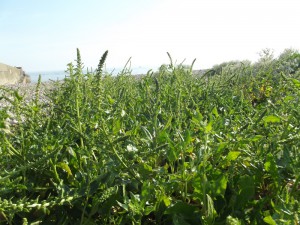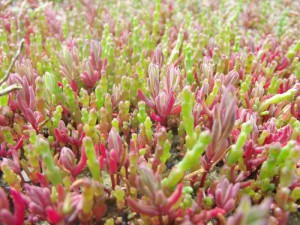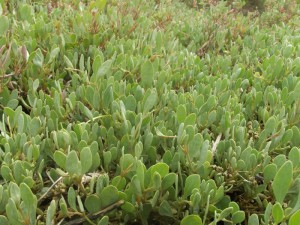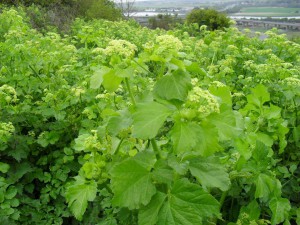Many of the best edible wild plants grow very close to the coast, which, of course, we have rather a lot of in the UK. These fall into three sub-categories. The first are the green seaweeds, which are actually primitive plants (unlike the brown and red seaweeds). The second are the saltmarsh plants that grow in areas immediately above the high tide line, or are partially submerged for short periods of time.
Marsh Samphire
The most famous of these is marsh samphire, which is actually a whole genus of plants (Salicornia) rather than a single species, including both annual and perennial species. Their traditional name was “Glassworts”, and long before people started eating them, they were burned to extract the silicates from them, which were then used in glassmaking processes. The name “samphire” rightfully belongs to a completely different plant, which now has to be called “Rock Samphire” to distinguish it from Marsh Samphire. Marsh Samphire was first collected as food as an adulterant to the more highly-regarded Rock Samphire – the true “Samphire”
Sea Purslane
Another saltmarsh plant, this one can be found in wild abundance. Where it grows – which is all around the southern coastlines of Britain and now becoming established ever further north, it often dominates utterly. It is naturally very salty, and tender, and is best served raw as a garnish to fish dishes. It can also be steamed for a short period of time, but not for too long or it will start to turn bitter.
Alexanders
The third sub-category of coastal plant are those that grow in areas close to the coast, but not actually close enough to ever get wet. These plants are salt-tolerant and usually wind-tolerant. The absolute best of these is a species brought to the UK as a food plant by the Romans, but which fell out of favour in the 19th century after the development of modern forms of celery. It can be grown inland, and even still survives in the wild in some places it was once grown (such as monastic ruins), but it only thrives near the coast. Alexanders (or Rock Parsley of Alexandria) is also very useful because it is one of the few wild greens that is available right through the winter – although it is at its best in May.
Sea Beet
 This plant is the wild ancestor of beetroot, sugarbeet and chard, which should tell you all you need to know about its relevance to a forager. Here shown growing by the marina on Brighton beach. Sea Beet is very common all around the coastline of Britain.
This plant is the wild ancestor of beetroot, sugarbeet and chard, which should tell you all you need to know about its relevance to a forager. Here shown growing by the marina on Brighton beach. Sea Beet is very common all around the coastline of Britain.




I forage for all these wild coastal and salt marsh plants through the year.
Sea beet;I am assuming that there are many varieties of this plant I have found two one with a leaf the colour of spinach and another much darker with its arterial stems a dark red veining the leaf.can you confirm?
Unidentified ; I was collecting sea purslane and checking the start of the samphire crop on salt marsh when I smelt the feint smell of curry.l traced it to a single plant species which I have do far been unable to identify.i tasted the stems leaves and seeds of this plant which all had a pleasing curry flavour and aroma. The plant looks at first glance like a grass grows in abundance on or just above the high tide mark.
it has grass like leaves of pale green
A central grass like stem which has a cluster of pale yellow green seeds grouped similarly to pepper corn
Can you help me to identify this plant for me?
And ley me know if it is edible?
Thanks and regards
Adrian
Hi Adrian
Your plant sounds like Marsh Arrowgrass, and if so then yes you can eat it.
And yes, sea beet is rather variable – I think probably down to the conditions it is growing in more than genetic differences.
Geoff
Should you include Sea Aster? mmmmmmmmmmmmmmmmmmmmmmmmmmmmmmmmmmmm
Hi Nicholas
This is just a randomly selected group of plants, not a comprehensive guide. I’m currently writing a book about that.
Geoff
Hi Geoff, did you write the book? Thank you for the information
Hi Sandi.
I am still working on the plant/seaweed book. Will be published in spring 2022.
Geoff
Thanks Geoff look forward to the book.
Just picked som sea pursulain, beet and samphire a couple of yards from out temporary front door.
Samphire I knew, thanks for the guidance on the other two.
Chris
You’re welcome.